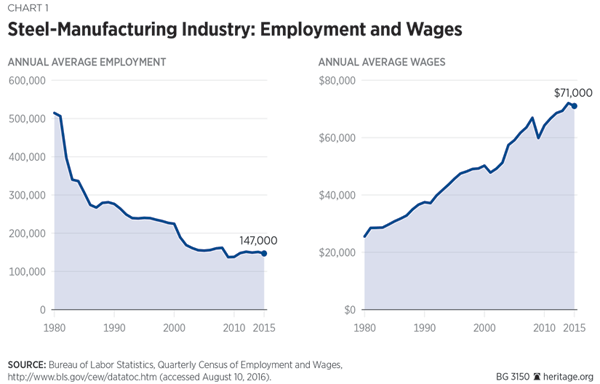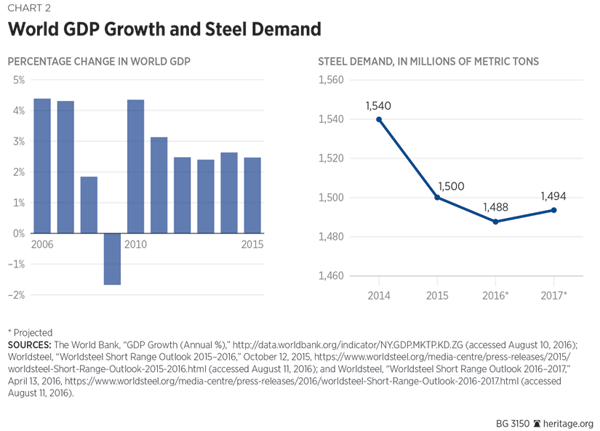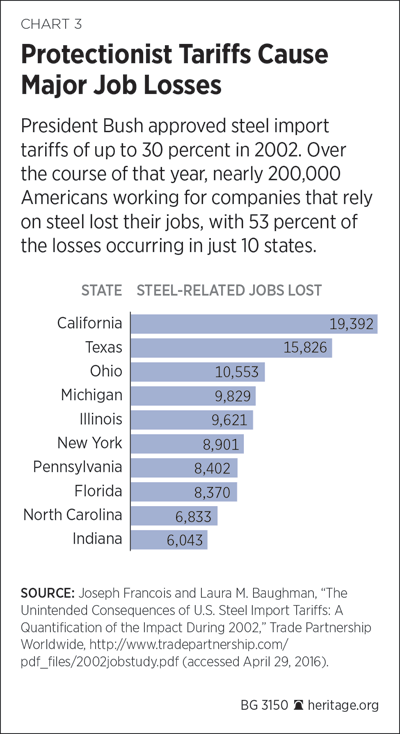Tori Whiting
Research Assistant
Tori helps to write, edit, and promote Heritage’s premier annual
publication, the Index of Economic Freedom, as a research assistant.
In response to alleged unfair trade practices, domestic steel producers are advocating for broad import restraints and immediate action by the U.S. government to protect the domestic industry. The federal government possesses a wide variety of tools to address these claims, but caution is required, because special interest tariffs for the steel industry will have negative consequences elsewhere in the domestic economy.
The U.S. manufacturing and construction industries rely on domestic and foreign steel to create finished products. Tariffs on steel imports limit choices and increase costs for these industries. Those costs are ultimately borne by American consumers and act as a tax on everyday goods made from steel, such as lawn mowers, washing machines, and microwaves.
Available tools to combat alleged unfair trade practices under domestic trade rules are permissible and viable options according to international norms, but showing favoritism for one industry at the expense of others can do far more harm than good. It is time for the U.S. government to stop implementing special interest, protectionist tariffs for domestic steel producers and embrace the principles of free trade to expand economic opportunity for all.
Technology Driving Changes in Steel-Making
Over the past century, technological advancements to increase efficiency and improve product quality have driven exponential change in the U.S. steel industry. Steel-making in the United States has traditionally been dominated by integrated steel mills: mills that use raw materials to produce steel products. Since the 1980s, however, greater emphasis has been placed on using recycled scrap metal to produce new steel, leading to the emergence of mini-mills in the U.S.Since 1870, integrated mills have used two types of furnaces to process iron ore and produce steel. The open-hearth furnace (OHF), used as the domestic best practice from 1870 to 1965, was attractive for its high capacity, but required hundreds of thousands of workers to operate. In 1952, the basic-oxygen furnace (BOF) was introduced, allowing steel producers to decrease production time while maintaining high capacity like the OHF, but requiring far fewer workers. In 1965, U.S. firms began to invest in BOF technology, and in just five years the furnaces accounted for approximately 50 percent of U.S. steel production.[1]
The electric-arc furnace (EAF), which existed as early as 1880, uses recycled scrap metal to produce new steel products. Due to its smaller capacity, efficiency, and adaptability, the EAF is the primary technology used in mini-mills. U.S. companies began establishing mini-mills in the late 1960s, and their popularity has surged since the 1980s. Today, mini-mills are responsible for producing more than 60 percent of all domestic steel.[2]
Not All Steel Is the Same
As steel-consuming industries have become more advanced, the demand for specialized steel products has grown. The majority of steel products used around the world today did not exist two decades ago.[3] EAF technology has allowed mini-mills, and even integrated mills, to meet the changing demands of steel consumers. According to Andy Harshaw, president and CEO of ArcelorMittal USA:Historically, integrated producers enjoyed a competitive advantage, uniquely capable of providing high-quality, value-added products that mini-mills couldn’t match. Today, mini-mills such as Steel Dynamics and Nucor are expanding their capabilities to target growth in our core markets, including automotive. As an example, Nucor is providing exposed panels for some new BMWs; a thought that was unheard of just five years ago.[4]Manufacturers operating in the “downstream” stage of production,[5] which use advanced steel products, require special types or grades of steel to produce their finished goods more easily. Domestic fastener manufacturers, for example, use a specific type of steel called cold-heading quality (CHQ) wire rod. “Most steel companies producing wire rod do not have dedicated CHQ production, but rather shift from ‘industrial quality’ or IQ wire rod to CHQ based on a variety of factors. This can lead U.S. fastener manufacturers to seek raw material from suppliers outside North America when U.S. production of CHQ is not available,” explained Rob Harris of the Industrial Fasteners Institute in recent testimony.[6] Harris goes on to explain that different steel-consuming industries need different products, and that the domestic steel industry is not capable of supplying everything that all industries need.
Steel Employment and Wage Changes
BOF and EAF technologies have not only driven change in the type of steel produced, but also in the number of workers required in the steel industry. Approximately 147,000 individuals were directly employed in steel manufacturing in 2015, representing a much leaner and more streamlined industry: Labor productivity has improved from an average of 10.1 hours per ton of steel in the 1980s (when 514,518 workers were directly employed) to just 1.9 hours per ton last year.[7]These advances have also led to a highly skilled workforce and increased average annual wages for steel workers. The steel industry demands aptitude in science, technology, engineering, and mathematics subjects, and many employees possess a two-year technical training degree or higher.[8] As demonstrated in Chart 1 the average annual steelworker wage in 2015 was approximately $71,000, and wages for steelworkers have been steadily increasing over the past few decades.
Mini-mills, which use electric-arc furnaces, have increased competition within the domestic steel market. They did so partly by capitalizing on opportunities in southern states in the 1980s. Because of their lean nature, as well as relatively low initial capital requirements compared to integrated mills, mini-mills surged in a region where worker unions were less common, scrap metal was abundant in largely untapped markets, and the mills could tap into niche-market needs.[9]
Current State of the Global Steel Market
Global steelmaking capacity was estimated by the Organization for Economic Co-operation and Development (OECD) to be approximately 700 million metric tons more than global demand last year.[10] Many individuals in the domestic steel industry argue that this overcapacity is a major problem because it results in a global steel surplus. This surplus stems from a variety of factors, but most notably the simple fact that the steel industry is inherently procyclical.When the global economy is thriving, consumers often have the ability to purchase a new car or other luxury goods they may not have been able to afford during an economic downturn. Governments, too, have more money to invest in major infrastructure projects, like building bridges. Simultaneously, the production of steel and manufactured goods made from steel grows to meet this increased demand.

Since 2012, global gross domestic product (GDP) has been growing annually by less than 3 percent, a significant reduction from previous years.[11] At the same time, steel demand has weakened, falling by 3 percent last year, as shown in Chart 2. The World Steel Association estimates that demand for steel products will increase in the next two years, but that growth will happen slowly.[12]
Despite these slowdowns, many countries, such as China, are continuing to produce large amounts of steel, creating a surplus and driving down the global price of steel. Chinese steel producers, which are primarily state-owned enterprises, use future infrastructure plans in emerging markets as justification for continuing to produce excess steel.[13]
Requests for Protection
Domestic steel producers have long argued that it is the duty of the federal government to protect the domestic market from alleged unfair international competition. The current discourse is no different as stakeholders in the U.S. steel industry are advocating “broad-based import restraints” and immediate action by the government in response to the behavior of China and other steel-producing nations during this global economic slowdown.In arguing this position, steelmakers have filed countless petitions under U.S. trade law ranging from temporary, product-specific and nation-specific tariffs, to overarching tariffs affecting a wide range of imports from around the world. While the government does possess a broad array of tools to combat unfair trade practices, all technically permissible under the World Trade Organization charter, it is crucial to use caution when engaging these tools. Tariffs meant to protect one industry can, and often do, have significant damaging effects on other domestic industries.
Anti-Dumping Duties. Anti-dumping duties, permissible under the Tariff Act of 1930,[14] are the most common tool used to combat alleged unfair trade practices. These special tariffs are imposed by the U.S. government on a specific foreign import that is believed to be priced unfairly and thus causing injury to a domestic market.[15]
The U.S. Department of Commerce and the U.S. International Trade Commission (ITC) conduct formal investigations of alleged unfair trade practices, typically following a petition from a domestic entity. The Commerce Department must determine whether the product in question is, in fact, being sold below fair market price, while the ITC determines if the corresponding industry is injured by the “dumped” product. Approved duties are required, under the Uruguay Round Agreements Act of 1994,[16] to go through a review investigation by the Commerce Department and ITC every five years to determine if the tariff is still necessary.[17]
Steel industry leaders claim that these special tariffs are needed to “create a level playing field” for domestic producers, yet they also admit to their lack of effectiveness in achieving that goal. Leo Gerard, international president of the United Steelworkers (USW), explicitly stated in submitted testimony that “[USW] has supported dozens of trade cases—primarily antidumping and countervailing duty cases—to try and address the flood of unfairly priced steel…but they have not been sufficient.”[18]
Currently, the U.S. has 75 anti-dumping and countervailing duty orders in place for iron and steel mill imports. Twenty-two have been ordered in the past two years alone, and the remaining 53 have undergone review investigations more than once. One order in particular, on stainless steel wire rod from India, has been in place since 1993.[19]
Alden Abbott, a senior legal fellow at The Heritage Foundation, states that “anti-dumping is in fact a form of special-interest cronyism that imposes high costs on Americans and thwarts beneficial competition.”[20] Despite their intended use as temporary tools to decrease injury to the domestic market, anti-dumping duties like this one against India are being used to “protect” domestic steel producers from having to compete with foreign companies.
Section 201 Tariff. An investigation of foreign trade practices under section 201 of the Tariff Act of 1930, also known as a safeguard investigation, is used to determine if an import is causing harm or injury to a corresponding domestic industry.
Imposing a tariff through section 201 requires action by the President following an investigation by the ITC. The ITC must prove that “there is clear evidence that increased imports of the article are a substantial cause of serious injury, or the threat thereof, to the domestic industry producing an article like or directly competitive with the imported article.”
U.S. steel industry leaders like Mark Millet, president and CEO of Steel Dynamics, claim that because anti-dumping duties are not solving the problem of cheap steel imports, “a Section 201 proceeding may be the only viable solution.”[21]
The use of a section 201 investigation to combat unfair trade practices is not common, and, when it is used, tends to result in “unintended consequences” for other domestic industries. In 2001, the ITC investigated the impact of all steel imports on the U.S. steel industry, and recommended that President George W. Bush impose tariffs of up to 30 percent on many steel imports.[22]
These tariffs, which went into effect in 2002, had serious negative effects on steel-consuming industries in the U.S. The decision to impose tariffs on steel also resulted in complaints by several nations at the World Trade Organization.[23] President Bush ordered the tariffs to be removed in December 2003.
As demonstrated in Chart 3, study by the Consuming Industries Trade Action Coalition (CITAC) found that 200,000 individuals in steel-consuming industries lost their jobs in 2002 because of higher steel prices, amounting to about $4 billion in lost wages.[24] The tariffs provided minimal relief to steel producers, but resulted in higher steel prices for American companies that rely on steel as a means of production. The cost of higher steel prices was not only borne by the companies, but also by every American family that purchased any product made from steel.

Section 232 Tariff. Under section 232 of the Trade Expansion Act of 1962,[25] the federal government has the ability to investigate foreign trade practices to determine the effects of imports on U.S. national security.
Imposing a tariff through section 232 requires action by the President following an investigation by the Secretary of Commerce, who has the authority to self-initiate an investigation. A section 232 investigation can also commence following a petition from an interested party or request from a department or agency head. The Secretary is required to find whether imports threaten to impair U.S. national security. The Secretary submits his recommendations to the President, who has 90 days to act. Section 232 tariffs are very uncommon and few have been ordered by the President following an investigation.
In 1999, the Secretary of Commerce found that petroleum imports were threatening to impair national security: Domestic oil reserves and production were low, and non-OPEC substitutes for petroleum did not exist. Despite these findings, the Commerce Department did not recommend the President exercise his authority under section 232. Like similar investigations in 1988 and 1994, it was concluded that “the costs to the national security of an oil import adjustment outweigh the potential benefits.”[26] The same would certainly be true in the case of steel.

Picking Winners and Losers
As demonstrated in the previous examples, using tariffs to protect one industry can have severe consequences on other parts of the domestic economy. To put this impact in perspective: The U.S. steel industry employed approximately 147,000 people in 2015; yet scores of other domestic companies need the steel produced by these individuals to create finished goods. In fact, steel-consuming manufacturers employ about 6.5 million people each year, and the construction industry supports another 6.3 million jobs.[27]Because raw materials represent a significant portion of the finished product for downstream manufacturers, it is crucial that these manufacturers receive the best products at the lowest costs. For some industries, that means buying foreign-made steel. When import tariffs are placed on this foreign steel, the industries that employ those 12.8 million Americans are on the losing end of this government favoritism.
Steel-consuming industries are not the only losers in this scenario. While stakeholders in the U.S. steel-making industry are shouting at the top of their lungs about China, Japan, South Korea, and other countries offering “unfair” steel prices, everyday Americans are struggling to afford a new washing machine or a refrigerator when the old one breaks down. Many of the goods they purchase, from lawn mowers to grills, are made of steel, and import tariffs raise the price of those goods. The special interest tariffs that steelmakers plead for are really just another tax on Americans and one more thing that makes it harder for average families to get by.
America Needs the Right Trade Policy
The debate between protectionist and free trade policies is not new in the United States. As President Ronald Reagan once put it:[28][W]e’re determined to press on with the right trade policy and, most important, to do all we can to shift the political focus away from negative, protectionist legislation to positive, pro-growth policies—policies like comprehensive tax reform and spending reduction…. The main question is not how to shelter the American economy but how to bring it into still wider contact with the rest of the world; not how to protect it from competition but how to release our boundless talent, creativity, and know-how so that America comes out of the competition a winner. After all, it’s not protectionism but economic growth that in the past [3.5] years has created more than 10 million American jobs.Reagan’s words find strong support each year in the Index of Economic Freedom,[29] which confirms that countries with greater levels of trade freedom enjoy higher levels of economic prosperity. Citizens in countries with low tariff rates and few non-tariff barriers enjoy higher per capita incomes, lower rates of hunger, and do a better job of protecting the environment. While the average tariff rate in the United States is 1.5 percent,[30] special interest tariffs and non-tariff barriers for steel and several other industries, which can be as high as 300 percent, hinder Americans’ freedom to trade.[31]
While steel industry leaders argue that it is the duty of the government to protect them from unfair competition, the duty of the government to reject favoritism for a specific industry over others and ensure a level playing field within the U.S. is even more crucial. Rather than immediately turning to protectionist tariffs for steel producers, the U.S. Trade Representative, the ITC, the Commerce Department, and Congress should work together to find solutions that keep U.S. markets open to innovation, competition, and economic opportunity for all.

No comments:
Post a Comment